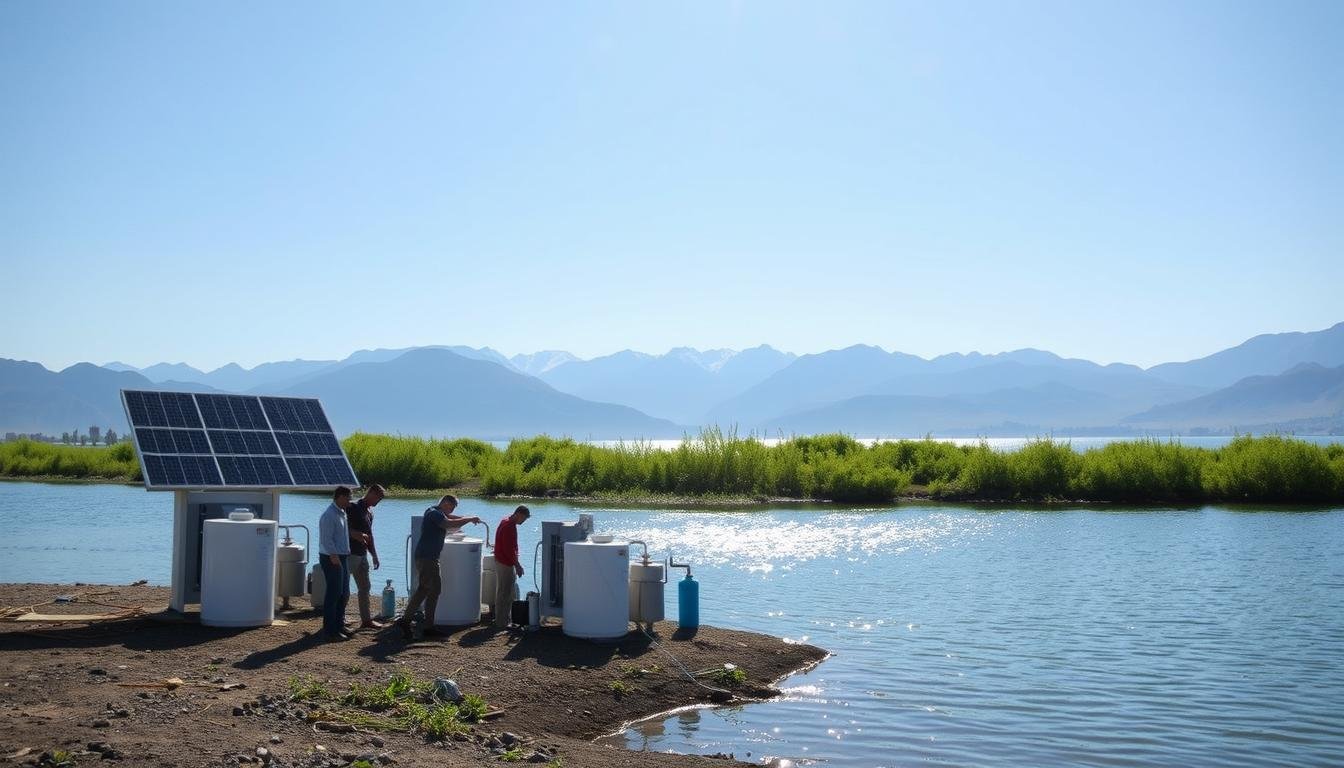Clean water is essential for everyone, but pollution can make it unsafe. Many solutions can improve water quality and keep it safe for the future. This article will highlight three sustainable methods to address water pollution.
By understanding these approaches, we can all help protect our water resources. This ensures everyone has access to clean water. Let’s explore these solutions!
Importance of Water Quality
High water quality is key for public health and the environment. It reduces pollution that harms humans and aquatic life. Clean water systems, including reclaimed water, provide safe drinking water and sanitation.
Poor water quality can hurt economic opportunities. It leads to higher costs in agriculture and water infrastructure. Communities face challenges from algae blooms and aquatic weeds in lakes and ponds.
Individuals and organizations can help by supporting water management initiatives. They can promote efficient toilets and engage in climate action. This includes managing stormwater runoff and using biocomposites in construction.
Improving septic tanks and tackling environmental challenges like nutrient runoff can also help. This ensures safe resources for future generations while supporting sustainable development practices.
3 Sustainable Solutions That Improve Water Quality
Constructed Wetlands
Constructed wetlands are engineered to treat wastewater naturally. They use plants and soil to filter out pollutants. This reduces water pollution caused by excess nutrients.
These systems enhance health by making reclaimed water suitable for irrigation. They also support sustainable development.
Constructed wetlands foster biodiversity, providing habitats for various species. They manage surface water and control algae growth. This is cost-effective due to low maintenance.
Well-designed and maintained constructed wetlands align with climate action goals. They address environmental challenges for future generations. By integrating clean technologies, they serve as reliable markers for effective water resource management.
Overview of Constructed Wetlands
Constructed wetlands mimic natural wetland functions to improve water quality. They consist of shallow basins filled with plants and soil. These systems manage surface water by treating it through biological processes.
They eliminate excess nutrients like phosphorus and nitrogen. This prevents algae growth in lakes and ponds. Constructed wetlands offer sustainable water solutions through wastewater recycling.
They support various designs, like free-water surface wetlands or subsurface flow wetlands. These are tailored to specific needs like septic tank effluent treatment or stormwater management. By integrating plants and biocomposites, they promote water sustainability and sanitation.
As a clean and profitable approach, constructed wetlands present economic opportunities. They contribute to climate initiatives, ensuring access to water resources for the future. They uphold the human right to clean water.
Benefits of Constructed Wetlands
Constructed wetlands offer ecological and economic benefits by improving water quality. They treat wastewater and remove nutrients. This reduces water pollution in lakes and ponds.
They can effectively use reclaimed water, contributing to a sustainable water supply. Constructed wetlands create habitats for plants and animals, promoting biodiversity. They enhance local ecosystems, supporting both recreational and economic opportunities.
They serve as natural buffers, managing stormwater by slowing down runoff. This helps protect groundwater and surface water resources. This aligns with climate action efforts and contributes to sustainable development practices.
Incorporating these wetlands into water management strategies supports ecological transitions. They address environmental challenges while providing a credible standard for responsible management of water infrastructure.
Bioremediation Techniques
Microbial Bioremediation
Microorganisms play a key role in microbial bioremediation. They break down pollutants like nitrogen and phosphorus in water. This helps clean up contaminated water systems by getting rid of algae blooms and managing weeds.
Studies show that these natural processes can restore lakes, ponds, and groundwater. This leads to better health and sanitation for communities. For example, wastewater treatment uses beneficial bacteria to break down pollutants, ensuring clean water.
But, there are challenges in using these methods everywhere. Things like different nutrient levels and external nutrient sources make it hard. Researchers need to find ways to overcome these issues to make water management better.
By doing so, microbial bioremediation can help keep water sustainable. It supports climate action and creates jobs for the future. It also makes sure we have access to clean drinking water.
Use of Microorganisms
Microorganisms are key in bioremediation, a method that improves water quality. They eat up excess nutrients like phosphorus and nitrogen, which cause algae blooms. In wetlands, they treat wastewater by absorbing contaminants and breaking down organic matter.
This process is vital for keeping drinking water safe and supporting farming. It also helps manage weeds, keeping lakes and ponds healthy. This approach supports sustainable water use and climate action.
Microbial action also improves groundwater quality and sanitation. They break down materials in septic tanks, making water systems more resilient. This transition to using microorganisms helps manage water sustainably, benefiting future generations.
Successful Implementations
Microbial bioremediation has been successful in many places. Constructed wetlands filter pollutants, treating wastewater and improving lake and pond health. They manage harmful nutrients, like phosphorus and nitrogen, which cause pollution and algae blooms.
Lessons from managing aquatic weeds show the importance of restoring shorelines. Introducing native plants prevents nutrient runoff into water bodies. This is key for surface and groundwater health.
By focusing on sustainable water practices, we can reduce pollution. This ensures clean drinking water for the future, supporting ecological transitions and climate action. Each success story shows how clean technologies and wastewater treatment can transform water management, creating jobs and protecting health and the environment.
Management of Aquatic Weeds
Ecological Approaches to Control
Ecological methods control aquatic weeds and algae sustainably. They target water pollution by addressing nutrient sources like phosphorus and nitrogen. Planting native species along shorelines reduces runoff and filters nutrients, supporting local ecosystems.
Wastewater treatment and recycling, like using reclaimed water for irrigation, support sustainable development. But, challenges exist, like balancing agricultural needs with clean water requirements and upgrading infrastructure.
There may also be resistance to effective water management due to economic interests. Innovations like biocomposites and efficient toilets can help this transition. They ensure clean water for the future and improve community health.
Benefits of Aquatic Weeds Management
Effective aquatic weeds management improves water health and diversity. It prevents harmful algae blooms that degrade water quality. This supports various aquatic species and fosters a balanced ecosystem.
Clean water conditions enable communities to enjoy activities like fishing and swimming. This boosts tourism and creates economic opportunities.
Controlling aquatic weeds improves water access for drinking and irrigation. This leads to better sanitation and health for residents. It supports sustainable development and aligns with climate action efforts.
Implementing strategies like wastewater treatment and water reuse can reduce water pollution. This approach positively impacts water resource management.
By promoting water sustainability, communities protect resources for future generations. They also benefit from improved water management practices.
Sustainable Water Management Practices
Rainwater Harvesting
Rainwater harvesting enhances sustainable water management and improves water quality. It captures runoff that would pollute lakes, ponds, or other bodies of water. Techniques like installing rain barrels or cisterns collect rainwater for irrigation, drinking, or sanitation.
Proper treatment facilities ensure this reclaimed water meets health standards. Community engagement is key in these initiatives. It promotes climate action and ecological transition.
Residents learn to conserve water and use efficient toilets. Educational programs encourage people to set up rainwater collection systems. Local governments offer incentives for development that includes rainwater harvesting.
This approach reduces water withdrawals from existing sources. It addresses external nutrient sources like phosphorus and nitrogen that cause algae blooms. Rainwater harvesting becomes a credible marker in water resource management for future generations.
Techniques for Rainwater Collection
Techniques for collecting rainwater include creating catchment areas on roofs. These direct runoff into storage tanks. A well-designed system should include filters to reduce debris and algae, ensuring the water remains clean.
Proper maintenance of these systems is important to avoid water pollution. Challenges like sediment accumulation and contamination from external nutrient sources can arise. Using biocomposites in tank designs can help maintain quality and reduce algae growth.
Regular inspections and employing efficient toilets to minimize water withdrawals serve as practical solutions.
Integrating rainwater collection systems with other features can enhance water management. This makes it easier to reuse this resource for irrigation or sanitation. Rainwater harvesting technologies, combined with wastewater recycling, offer pathways to ensure a sustainable water supply.
This contributes to a cleaner environment and supports ecological transition efforts. By addressing these challenges, communities can harness rainwater effectively for future generations. This promotes sustainable development while addressing climate change.
Community Engagement in Water Sustainability
Community involvement is important for improving water quality and achieving sustainable water practices. Local stakeholders, including farmers and residents, offer valuable insights into water resource management. This can improve educational initiatives related to wastewater treatment and water reuse.
This engagement fosters economic opportunities for agriculture while supporting clean technologies that tackle water pollution. Collaborative efforts with government agencies and non-profits can lead to initiatives like efficient toilet programs and septic tank upgrades. These enhance sanitation and minimize nutrient runoff into surface water.
Joint efforts in lake management, including the treatment of external nutrient sources like phosphorus and nitrogen, can effectively reduce algae growth in ponds and other waterbodies. By working together, communities can implement impactful water infrastructure projects.
These ensure fair access to safe drinking water for future generations while addressing environmental challenges posed by climate change and pollution. Involving the local population in these solutions empowers them. It also serves as a meaningful indicator of progress in the transition toward water sustainability.
Educational Programs and Initiatives
Educational programs emphasize sustainable water practices. They instruct communities on water quality and the significance of minimizing water pollution. Workshops and presentations highlight how excess nutrients, such as phosphorus and nitrogen from agriculture and wastewater systems, negatively impact lakes, ponds, and groundwater.
Initiatives assess their effectiveness through surveys that gauge changes in water management habits. This includes increased water reuse and enhanced sanitation methods like efficient toilets. Collaborations with schools and organizations strengthen these efforts by integrating clean technologies into the curriculum.
They advocate for climate action and promote responsible approaches to development. Teaming up with local governments improves the application of wastewater recycling and lake management strategies. This raises awareness of their responsibility in ensuring future generations have access to safe drinking water.
These all-encompassing approaches tackle environmental challenges and foster economic opportunities. They reinforce the notion that clean water is a fundamental human right for health and well-being.
FAQ
What are the key benefits of using rain gardens for improving water quality?
Rain gardens filter stormwater runoff, reducing pollutants like sediment and nutrients. They also promote groundwater recharge and enhance local biodiversity. For instance, planting native species attracts beneficial insects. Capturing excess rain prevents flooding and erosion in nearby areas.
How does green infrastructure contribute to sustainable water quality management?
Green infrastructure uses natural systems to filter pollutants. Rain gardens, green roofs, and permeable pavements are examples. These practices improve water quality and promote biodiversity while reducing flooding.
What role do constructed wetlands play in improving water quality?
Constructed wetlands filter pollutants, absorb nutrients, and provide habitat for wildlife. They can treat agricultural runoff by removing fertilizers and sediments. This reduces algal blooms in nearby water bodies and supports biodiversity.
How can community awareness and involvement lead to better water quality solutions?
Community awareness fosters collaboration. It enables residents to participate in clean-up events and advocate for sustainable practices.
For example, organizing local workshops on pollution reduction techniques or forming neighborhood associations can lead to improved wastewater management. This ultimately enhances water quality.
What are some effective practices for reducing agricultural runoff to protect water quality?
Implement buffer strips of vegetation along water bodies. Practice cover cropping to improve soil health. Rotate crops to enhance biodiversity. Use precision agriculture to apply fertilizers efficiently.
Install rain gardens to absorb runoff and reduce pollutants entering waterways.







